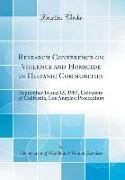- Start
- Research Conference on Violence and Homicide in Hispanic Communities
Research Conference on Violence and Homicide in Hispanic Communities
Angebote / Angebote:
Excerpt from Research Conference on Violence and Homicide in Hispanic Communities: September 14 and 15, 1987, University of California, Los Angeles, ProceedingsViewing assaultive injury as a public health problem has many potential benefits over the traditional view of violence as a criminal justice problem. First, the public health perspective broadens our horizons as to the range of potential strategies for prevention far beyond the defensive or reactive postures that have dominated traditional thinking. Second, the adoption of this perspective unleashes substantial public health research and program resources to bear on an issue resources which were until recently unavailable. Third, the publicity given to the public health implications of violence via the media and conferences will help to create a constituency of public support for research and programs focused on preventing violence.A major impetus behind the movement to address assaultive injury as a public health problem came from the Task Force on Black and Minority Health of the Secretary of the u.s. Department of Health and Human Services (dhhs) in 1985 (i). This task force clearly identified the types of mortality and morbidity that account for the disparity in death and illness borne by minority groups in the United States. Homicide was identified as a major cause of this disparity. Among Mexican-born Hispanics, homicide accounted for 55% of deaths that would not have occurred had their mortality rate equalled that of non-hispanic whites excess deaths). Homicide accounted for 100% of the excess deaths borne by Cuban-born Hispanics. Clearly, although these data may not represent the experience of all Hispanics in the United States, they are sufficient, along with other information that we have, to indicate that to improve the health of Hispanics in the United States we cannot ignore the issue of assaultive injury.Consider the quantitative dimensions of assaultive injury among Hispanics as a public health problem. Seven factors that epidemiologists and other public health professionals use to measure the importance of a public health problem include the following: 1) magnitude of mortality, 2) rank as a cause of death, 3) rank as a cause of premature mortality, 4) magnitude of morbidity, 5) trends in morbidity and mortality, 6) economic costs of a disease, 7) potential for spread, and 8) preventability of a disease.About the PublisherForgotten Books publishes hundreds of thousands of rare and classic books. Find more at www.forgottenbooks.comThis book is a reproduction of an important historical work. Forgotten Books uses state-of-the-art technology to digitally reconstruct the work, preserving the original format whilst repairing imperfections present in the aged copy. In rare cases, an imperfection in the original, such as a blemish or missing page, may be replicated in our edition. We do, however, repair the vast majority of imperfections successfully, any imperfections that remain are intentionally left to preserve the state of such historical works.
Folgt in ca. 10 Arbeitstagen
